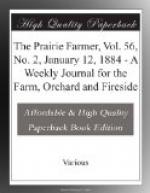J.N. Muncey,
Asst. Ag. Expts.
Ag. Col., Ames, Iowa.
PUBLIC SQUARES IN SMALL CITIES.
By H.W.S. Cleveland.
A respectable looking, middle-aged gentleman called upon me not long since and told me he was a resident of an interior city of some eight or ten thousand inhabitants, and at a recent public meeting had been appointed chairman of a committee on the improvement of a small park, which it was thought might be made an attractive ornamental feature of the town.
On further inquiry I learned that the proposed park was simply a public square with a street on each of its four sides, on which fronted the principal public buildings, stores, etc. It was a dead level, with no natural features of any kind to suggest the manner of its arrangement, but they thought it might be made to add to the beauty of the town, and he had called to ask my advice in regard to it.
As the arrangement of such areas had occupied my thoughts a good deal in a general way, it occurred to me that this was a good opportunity to ventilate some opinions I had formed in regard to prevalent errors in their management, and accordingly I addressed him substantially as follows:
“It is very rare that the people of any town show a just appreciation of the value of such an area for ornamental use. Such a piece of ground as you describe in the very business center of a town must of course possess great pecuniary value, and the fact that it has been voluntarily given up and devoted for all time to purposes of recreation and ornament would lead us to expect that they would at least exercise the same shrewdness in securing their money’s worth, that they do in their private transactions. They have given this valuable tract for the object of ornamenting the town by relieving the artificial character of the buildings and streets by the refreshing verdure of trees and grass and shrubbery, and that it may afford a place for rest and recreation for tired wayfarers and laborers, and nurses with their children, and a pleasant resort for rest and refreshment when the labors of the day are at an end.
“Its arrangement, therefore, should be such as to set forth these objects so obviously that no one could look upon the scene without perceiving it. The trees should be so arranged in groups and in such varieties as would afford picturesque effects when seen from the principal points of approach. The paths and open areas should be so arranged as to prevent the possibility of saving time by a short cut across, and so provided with seats under the shade of the trees as to invite to repose, instead of this, in nine cases out of ten, the trees (if any are planted) are simply set in rows at equal distances, without the faintest attempt at picturesque effect, and the paths are carried diagonally across from corner to corner for the express purpose of affording an opportunity for a short-cut to every one who is hastening to or from his business. The consequence is that at certain hours the paths are filled by a hurrying throng whose presence would alone suffice to banish the effect of repose which should be the ruling spirit of the place, while at all other times it is comparatively deserted.




